Retterspitz ingredients
Retterspitz stands for healing, caring and wellbeing. The company has always believed in the effectiveness and tolerability of natural ingredients and traditional healing techniques.
It’s what’s inside that counts
- Almond oil
- Avocado oil
- Bamboo extract
- Basil
- Bergamot
- Birch extract
- Black cumin oil
- Bladder wrack extract
- Calendula flower extract
- Cardamom
- Chamomile flower extract
- Caraway oil
- Cocoa butter
- Eucalyptus oil
- Eucalyptol
- Freesia
- Ginger extract
- Grapefruit extract
- Hops
- Horsetail extract
- Hyaluronic acid
- Jasmine
- Jojoba oil
- Juniper
- Lavender
- Lemon verbena scent
- Menthol
- Mint oil
- Mountain pine oil
- Nettle extract
- Olive oil
- Orange extract
- Orange peel
- Peanut oil
- Peppermint oil
- Spruce needle oil
- Rice protein
- Rosemary oil
- Sandalwood
- Sea salt
- Shea butter
- Spearmint
- St. John's wort extract
- Sunflower oil
- Thyme oil
- Thymol
- Walnut shell extract
- Wheat protein
- Witch hazel extract
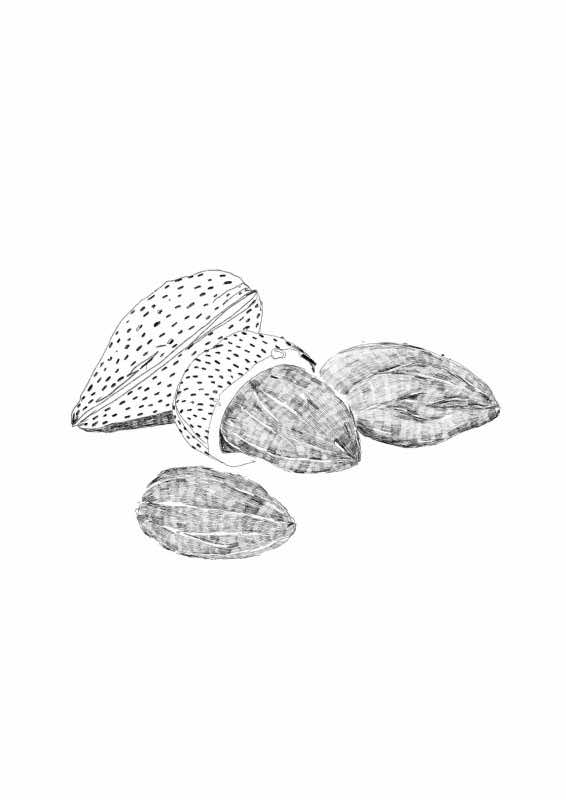
Almond oil
Originally from Southeast Asia, almond trees are said to have been introduced to Germany by the Romans. They grow best in a Mediterranean climate; however, the biggest harvests come from North America. Sweet almonds are pressed to extract the oil, which is then refined. It is a particularly mild and valuable base for oils and creams: especially suited for sensitive and dry skin as well as babies’ skin. Almond oil is easily absorbed by the skin and provides a lot of moisture. The oil is high in unsaturated fatty acids. They create a thin film on the skin to prevent it drying out.
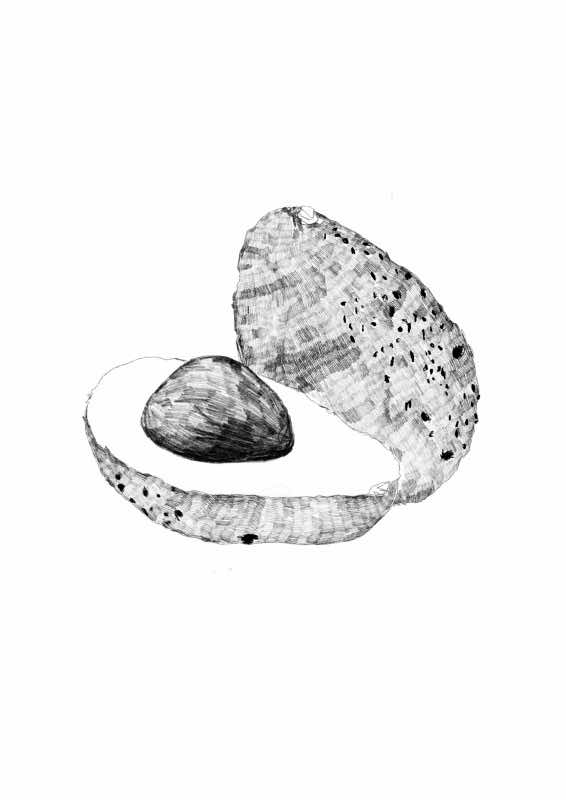
Avocado oil
The avocado tree is part of the laurel family and originates from the forests of South Mexico and the tropical and subtropical area of Central America. Botanically speaking, its pear-shaped fruits are actually berries. When ripe and soft, the yellowy-green flesh is cold-pressed to extract the oil. It is rich in unsaturated fatty acids. It moisturises the skin. Its wide variety of vitamins provides protection against harmful influences and stimulates the regeneration of the skin. The oil is absorbed quickly without blocking the pores.
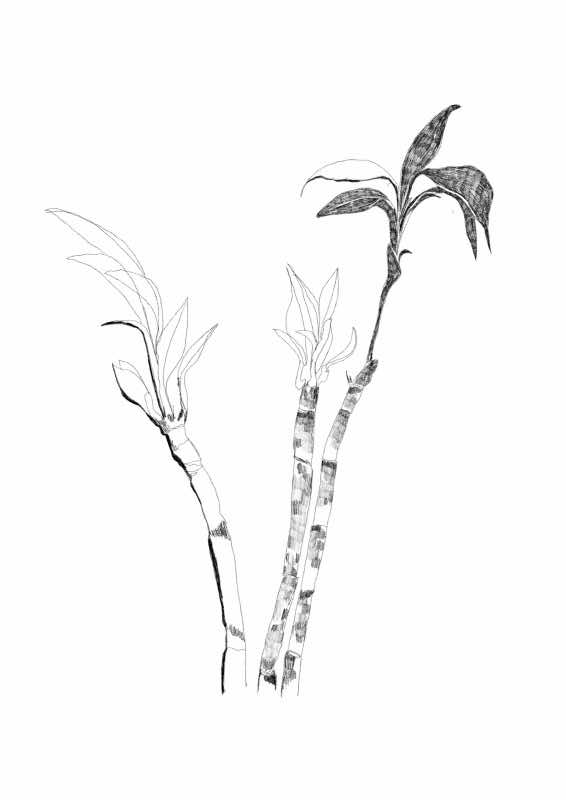
Bamboo extract
The bamboo plant – strictly speaking a woody grass – is known for its rapid growth, excellent stability and flexibility. It is the richest source of natural silicon (silica), which is essential for the special properties of this plant. In the human body, the trace element silicon is responsible for the generation and health of the skin, hair and nails and is supplied by certain foods. When used as an ingredient in shampoos and deep conditioners, bamboo extract makes the hair strong and gives it a glossy, healthy appearance.
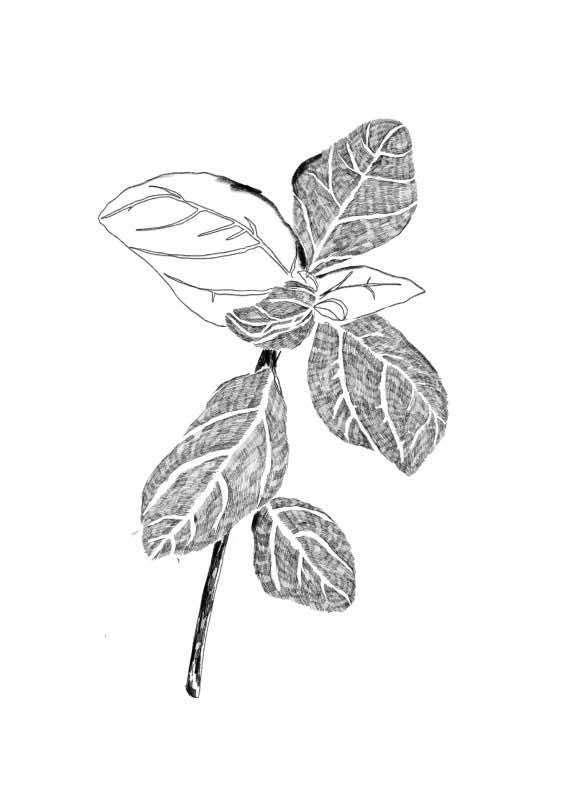
Basil
The top note of a perfume unfolds as soon as the bottle is opened and the fragrance is released. It is perceived only briefly and generally consists of a light, fresh and stimulating leafy-green scent, which leaves behind an initial impression and then gradually fades after around 15 minutes. Basil, our Mediterranean seasoning herb, has this kind of green, herby and sweet scent which lifts the spirits, has a soothing yet stimulating effect and invigorates and sharpens the mind.
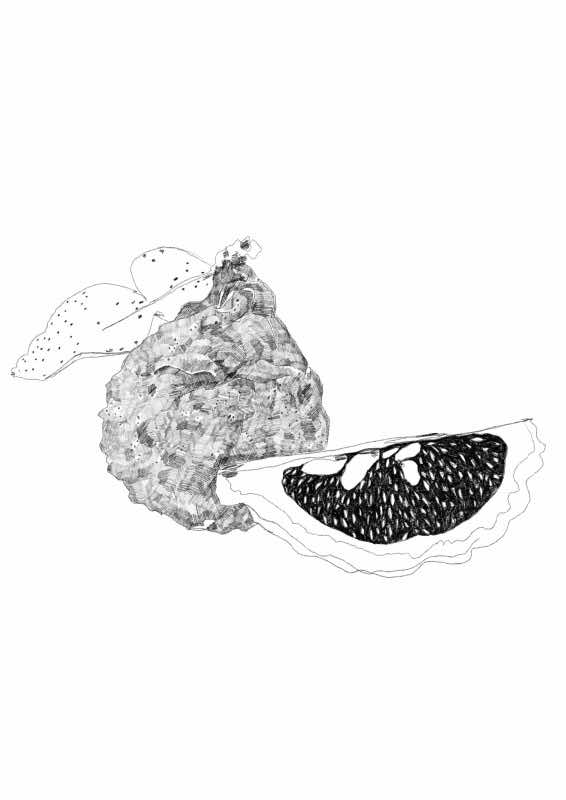
Bergamot
The top note of a perfume unfolds as soon as the bottle is opened and the fragrance is released. It is perceived only briefly and generally consists of a light, fresh and stimulating leafy-green scent which leaves behind an initial impression and then gradually fades after around 15 minutes. Bergamot, a cross between lime and bitter orange, has a fresh, fruity and divinely light scent. The fragrance has a positive effect on our wellbeing: it calms, balances and stabilises while gently brightening the mood.
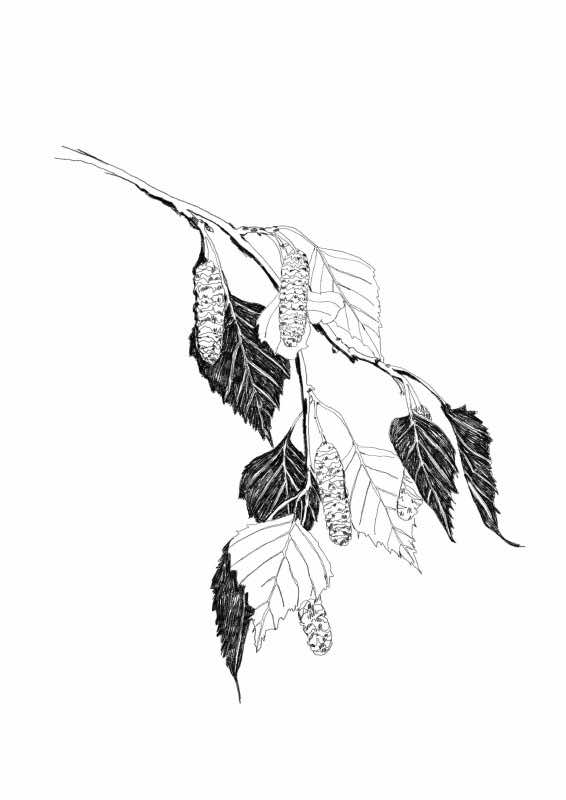
Birch extract
The birch tree grows all over the northern hemisphere and can easily be identified by its characteristic white bark. Its leaves can be used to produce an extract that is rich in flavonoids, saponins, tannins, essential oils and vitamin C. In shampoos, rinses and deep conditioners, this variety of caring and nourishing substances ensures a healthy scalp with good blood circulation. They alleviate complaints such as greasy hair, activate the roots of the hair and strengthen the hair overall. The extract of young birch leaves the hair and skin with a pleasant sensation.
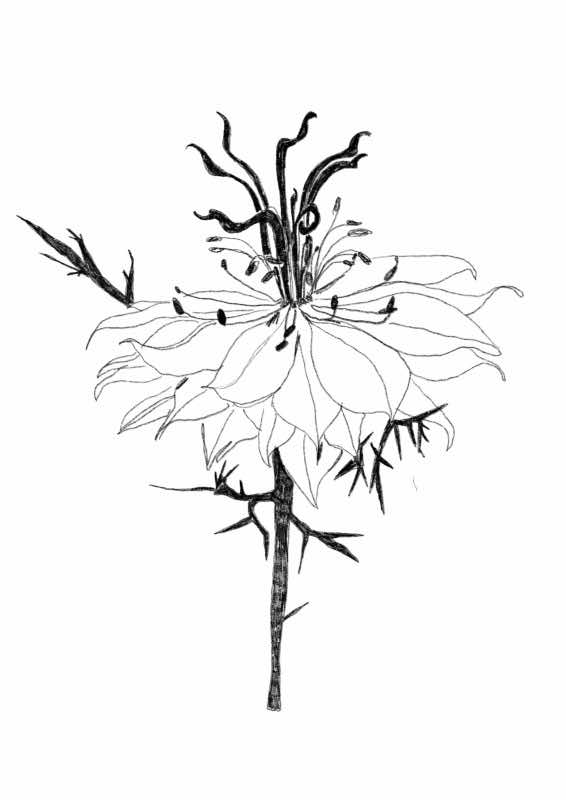
Black cumin oil
Black cumin is not related to true cumin. It can be found in the Mediterranean, in West Asia and in India. This herb member of the buttercup family has delicate white flowers and the essential oil is extracted from the plant’s small black three-sided seeds. It is rich in unsaturated fatty acids, minerals, trace elements and vitamins. When used in skincare, the fatty acids support cell regeneration. The oil alleviates skin irritation and itching and prevents the skin drying out. The skin is generally improved and soothed.
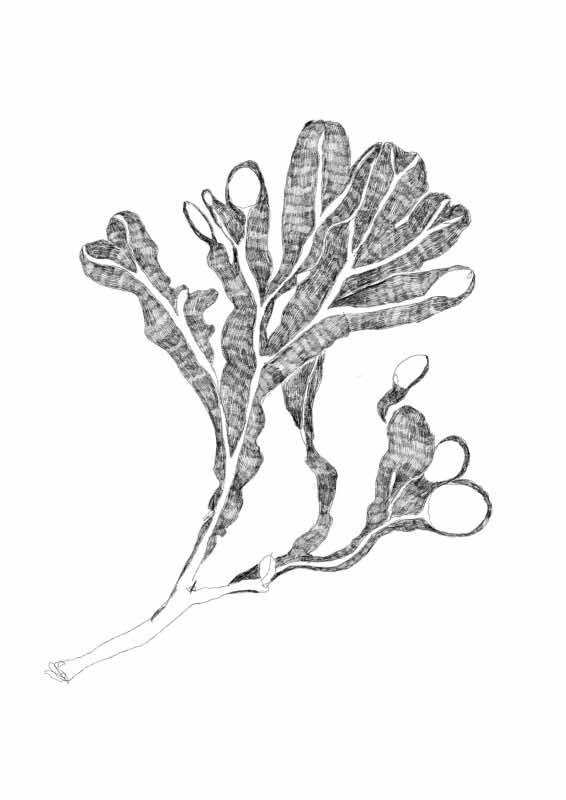
Bladder wrack extract
Bladder wrack is a common brown alga that can be found on the North and Baltic Sea coasts of Germany. Particularly large populations have been documented off Heligoland. This alga is named for its clearly visible air bladders. Anchored to the sea floor by a holdfast, these bladders give it buoyancy and reach. Bladder algae are rich in essential minerals and trace elements, which are important for intensive skin care. Bladder wrack extract nourishes the skin and protects it against free radicals. The ingredient’s anti-bacterial properties soothe the skin and keep it in good condition.
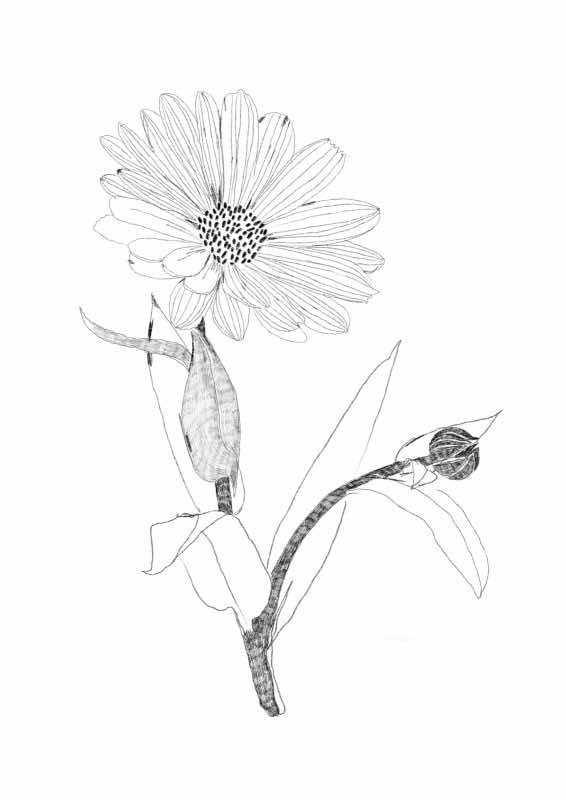
Calendula flower extract
The uses of calendula were identified and described by Abbess Hildegard of Bingen as long ago as in the 12 century. The plant is grown predominantly in Germany and the Netherlands today, and the extract is taken only from its magnificently bright yellowy-orange flower. It contains valuable substances such as flavonoids and carotenoids. Calendula extract stimulates the regeneration of the skin, soothes irritated skin and alleviates other irritations. Creams that contain this ingredient are therefore particularly suited for the daily care of dry and stressed skin.
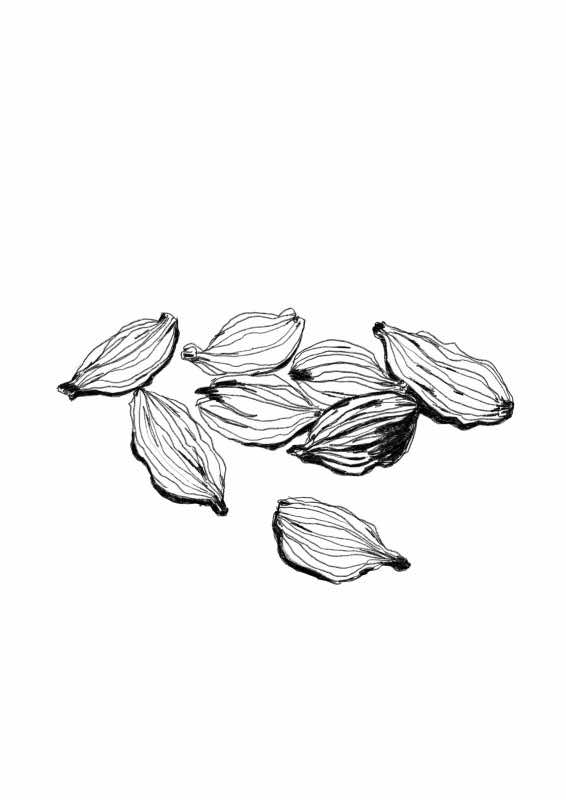
Cardamom
The top note of a perfume unfolds as soon as the bottle is opened and the fragrance is released. It is perceived only briefly and generally consists of a light, fresh and stimulating leafy-green scent which leaves behind an initial impression and then gradually fades after around 15 minutes. The essential oil is extracted from the seeds of this herbaceous plant and has an exotically spicy scent. It is known for strengthening the mind and soul, increasing concentration and restoring balance.
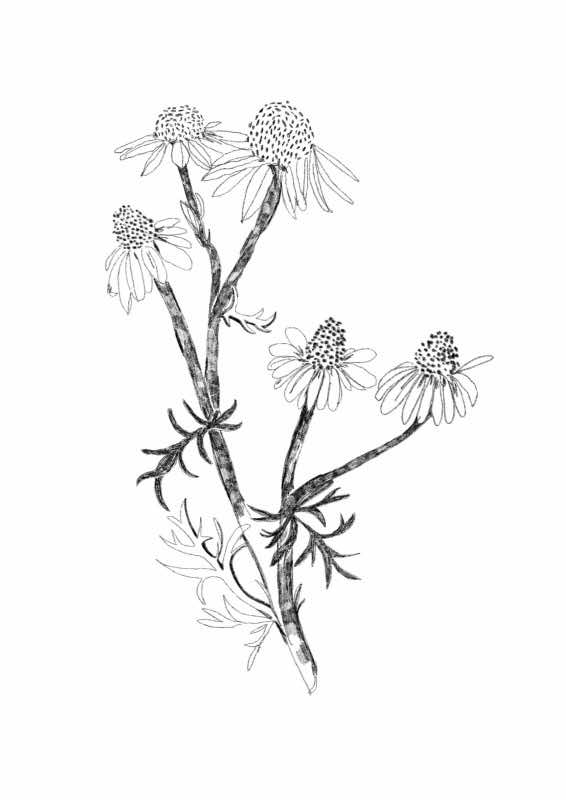
Chamomile flower extract
Originally from the Middle East and Southern and Eastern Europe, true chamomile can now be found throughout Europe. Chamomile is an annual herby plant rich in essential oil, flavonoids and mucilage. The extract is taken from the small white and yellow flowers, which have a pleasantly aromatic scent. Chamomile extract contains substances that are used in medically effective remedies for their anti-inflammatory, antibacterial and cramp-relieving properties. As an ingredient in care products, chamomile flower extract soothes and protects the skin and supports its regeneration.
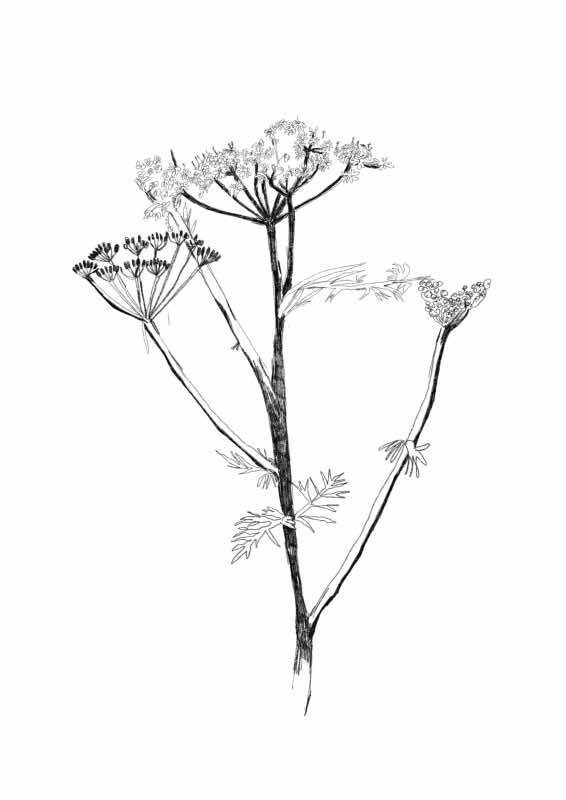
Caraway oil
True caraway is originally from the Middle East and the region around the Mediterranean Sea. Only the sickle-shaped seeds, known predominantly for their intense flavour as a seasoning, are taken from the herb-like plants. The oil, which is extracted from the seeds through steam distillation, has many uses. The substances it contains have anti-microbial properties, which means that, when used as an ingredient in oral care products, it not only provides preventative protection, but also alleviates bad breath caused by an imbalance of microflora in the mouth and throat areas.
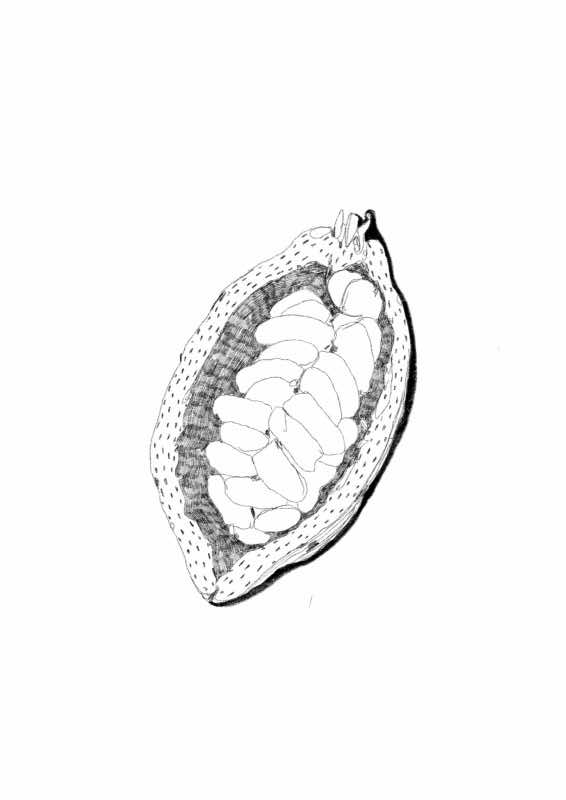
Cocoa butter
Cacao trees only bear fruit in an area that straddles the equator like a narrow belt. When ripe, this fruit has to be harvested by hand with the help of machetes or sticks. The seeds of the cocoa fruit are pressed to produce cocoa mass, which is then further pressed to turn it into cocoa butter. Cocoa butter is high in saturated and unsaturated fatty acids and contains numerous vitamins, minerals and antioxidants. It smooths and moisturises the skin, leaving behind a pleasant feeling.
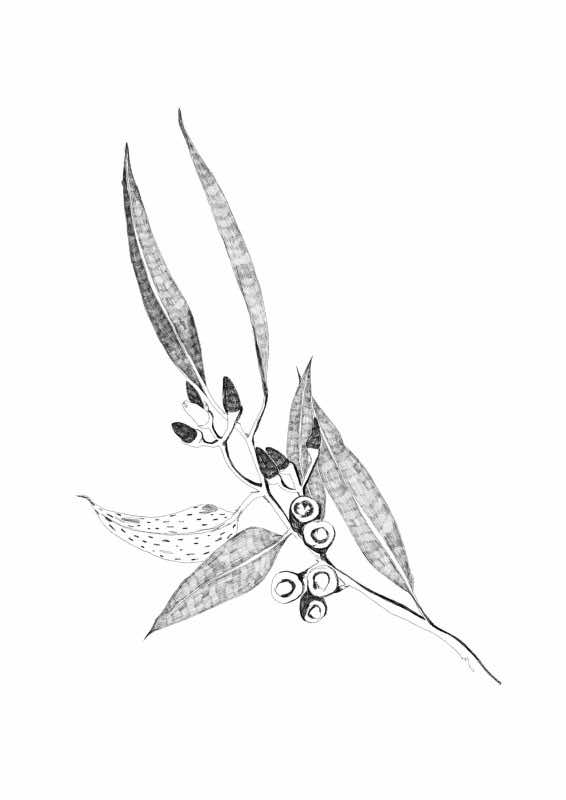
Eucalyptus oil
Originally, eucalyptus trees could only be found on mainland Australia and Tasmania. Today, they grow in all of the world’s warmer regions and are cultivated for wood or paper in some places. The essential oil is extracted from the dried leaves of the eucalyptus trees, which are a by-product of timber production. Eucalyptus oil is especially high in cineole. This substance gives the oil anti-microbial and fungicidal properties, making it perfect for maintaining oral health and preventing tooth decay and gum disease.
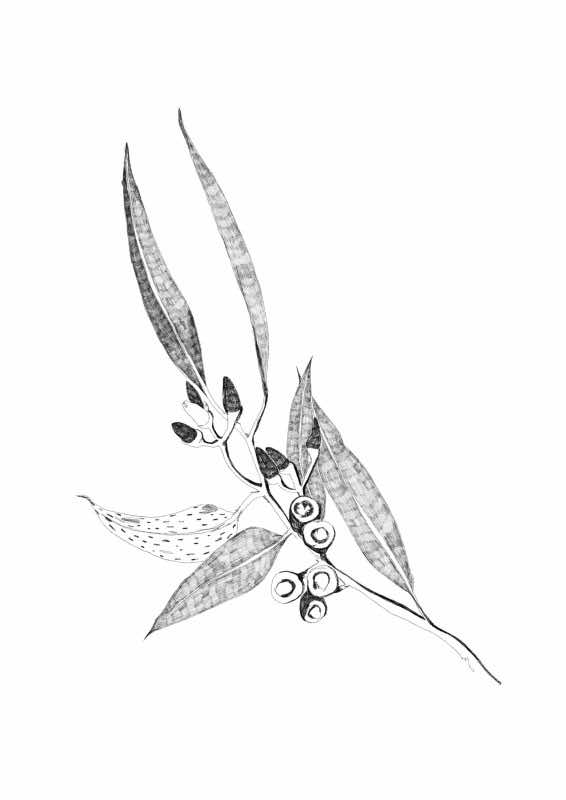
Eucalyptol
Large volumes of eucalyptol, also known as 1,8-cineole, can be extracted from eucalyptus oil through fractional distillation. Eucalyptol is named for eucalyptus and its essential oil, because it makes up 85% of essential eucalyptus oil. Eucalyptol can also be found in seasoning herbs such as sage, rosemary, marjoram and basil. It has a characteristic, fresh scent and opens up the bronchi, improves breathing and makes it easier to breathe more deeply. This improves the oxygen supply throughout the whole body and improves general wellbeing.
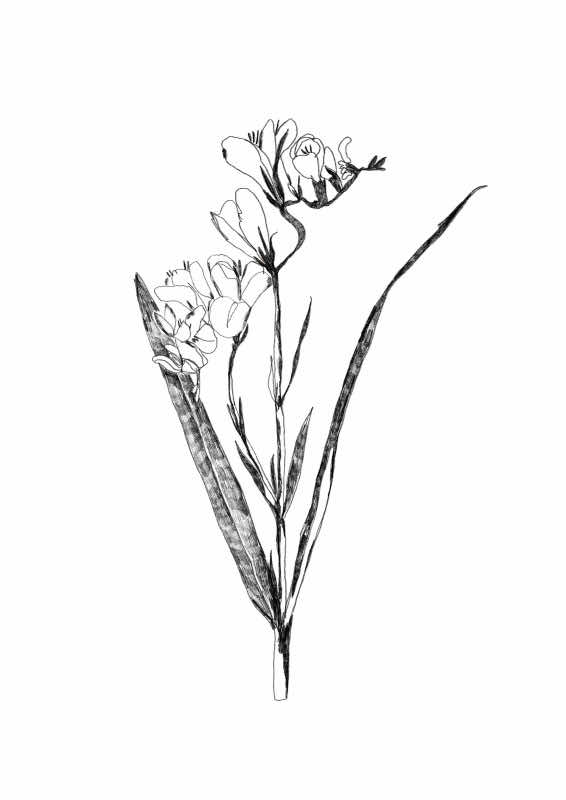
Freesia
The heart note of the perfume develops as the top note gradually evaporates. It lasts longer, mixes with the body’s natural scent and creates a personal fragrance. Here, floral notes with warming, harmonising properties are preferred. Freesia, which originates from South Africa, is known as the flower of love and devotion. Its rows of brilliant blossoms come in a wide range of colours, from white to violet. The effect of its sweet, fresh floral scent is both refreshing and calming. Tension is reduced, while the mind remains alert.

Ginger extract
Ginger grows in tropical and subtropical regions all over the globe. Only the rhizome of the plant is useful as a spice or a medicinal drug. The part of the plant above the ground, which is similar to a reed plant, is not used. The rhizome is predominantly harvested by hand. It has a characteristically spicy, lemony, herby aroma. Spicy compounds in the plant, such as gingerol, dilate the blood vessels and ensure good blood flow to the skin. The vitamin C it contains is a natural antioxidant and protects the skin against harmful environmental influences.
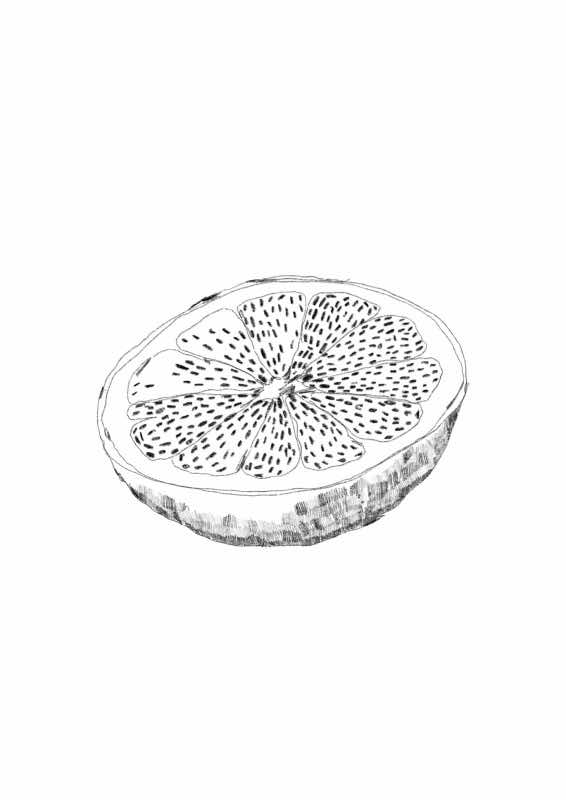
Grapefruit extract
Grapefruit extract is taken from the flesh of the ripe fruit and is high in vitamin C. The essence has a pleasantly fresh, fruity and invigorating scent. Care products with this ingredient give the skin a real boost of energy: they stimulate the blood flow and have astringent and antioxidative effects. This way, they revitalise the skin, actively protect it against free radicals, improve its texture and keep it in good condition. The combination of various citrus extracts can even strengthen these effects.
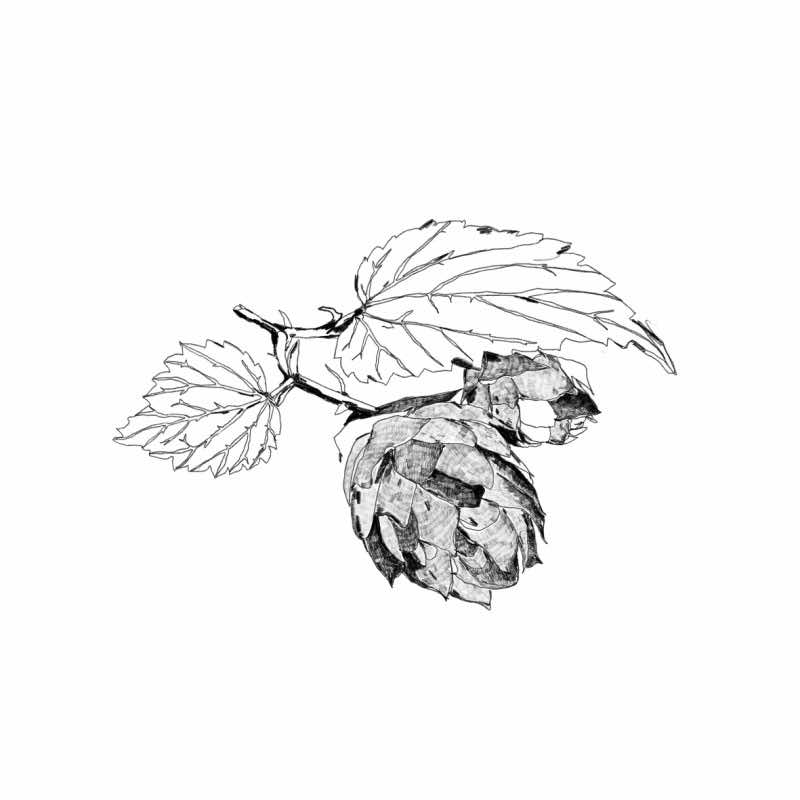
Hops
Wild hops can be found throughout Central Europe. It is better known as a cultivated plant whose bitter substances give beer its typical aroma. The cone-shaped female inflorescences, the umbels, are not only used for the production of beer; the umbels are also used for other preparations. What is less known is the calming effect of hops, which were used early on as a sleeping pill and sedative. In bath additives, hop extract relaxes the body and mind.
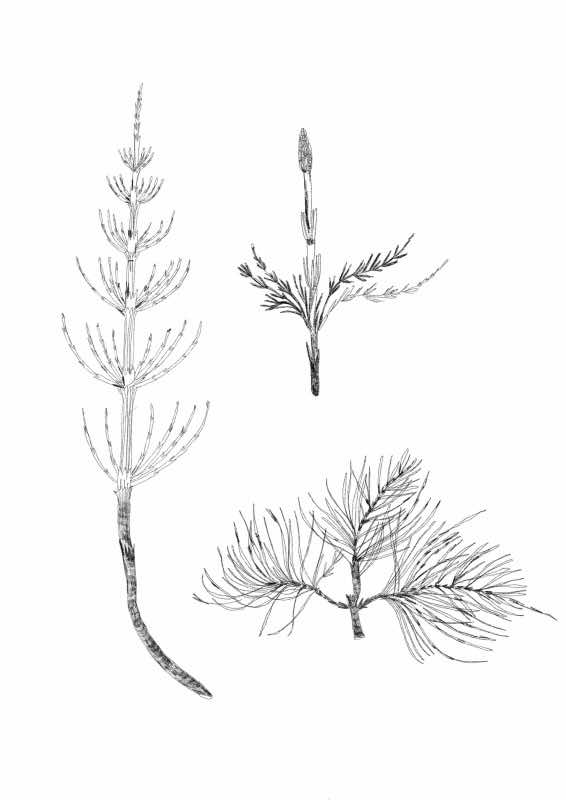
Horsetail extract
Horsetail is a plant that can be found throughout the northern hemisphere and can grow up to 40 cm tall. It is one of the world’s oldest plants, and – according to fossil evidence – in the Carboniferous period it grew to a height of 30 m and formed vast forests. Today, it is most often found on loamy field edges, embankments and meadows. These plants are high in flavonoids and rich in silica (silicon), which is what gives horsetail its firm texture. When used in hair care, horsetail extract stimulates the metabolism of the skin, while fortifying and strengthening the structure of the hair.
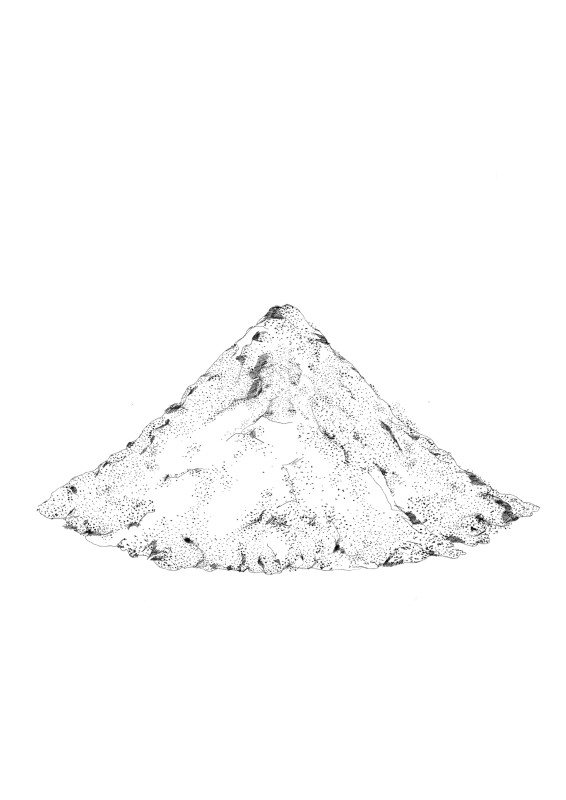
Hyaluronic acid
Hyaluronic acid is a naturally occurring substance in the body, primarily known for its ability to retain a significant amount of moisture. In the skin, it ensures firmness and elasticity by storing water, resulting in a smoothing effect. As we age, the natural production of hyaluronic acid decreases, which is why it is often used in skincare products to provide hydration and reduce fine lines and wrinkles.
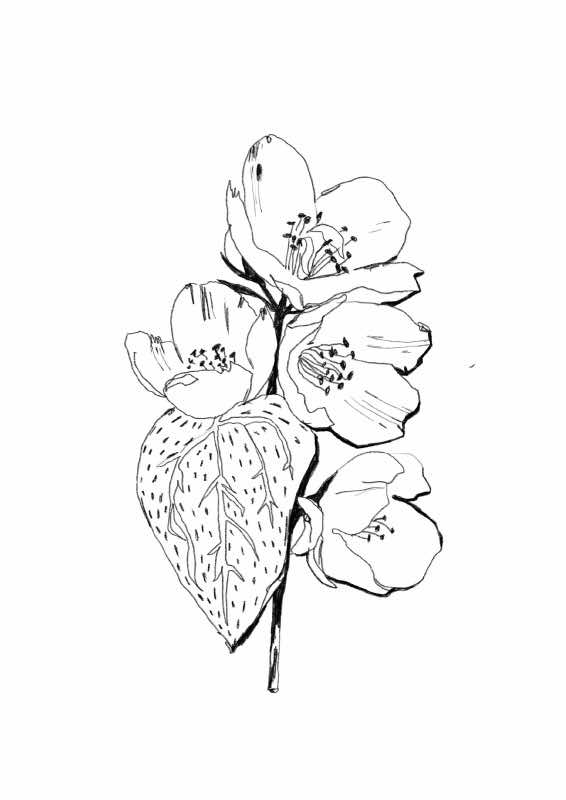
Jasmine
The heart note of the perfume develops as the top note gradually evaporates. It lasts longer, mixes with the body’s natural scent and creates a personal fragrance. Here, floral notes with warming, harmonising properties are preferred. Jasmine’s star-shaped white flowers, which are plucked early in the morning before sunrise, have a captivating, sensual, delicate, floral scent. This invigorating fragrance encourages positive thoughts and improves the mood. The mind is fortified and the emotions rebalanced.
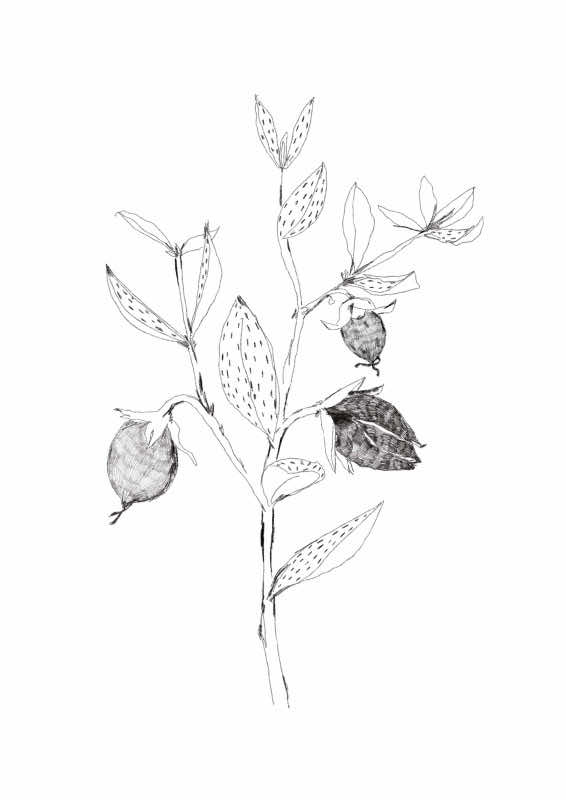
Jojoba oil
Jojoba is native to the dry areas of Mexico and the southwest of North America. The oil, which is extracted from the nut-like seeds on the evergreen shrub, is actually a wax that only looks like an oil because it becomes a liquid at room temperature. Because it has a similar structure to the waxes in our skin, it is excellent at preventing the skin drying out without leaving behind an oily film. It is also high in monounsaturated fatty acids and rich in vitamins. It protects the skin against free radicals, promotes the regeneration process in stressed skin and is a valuable anti-ageing ingredient.
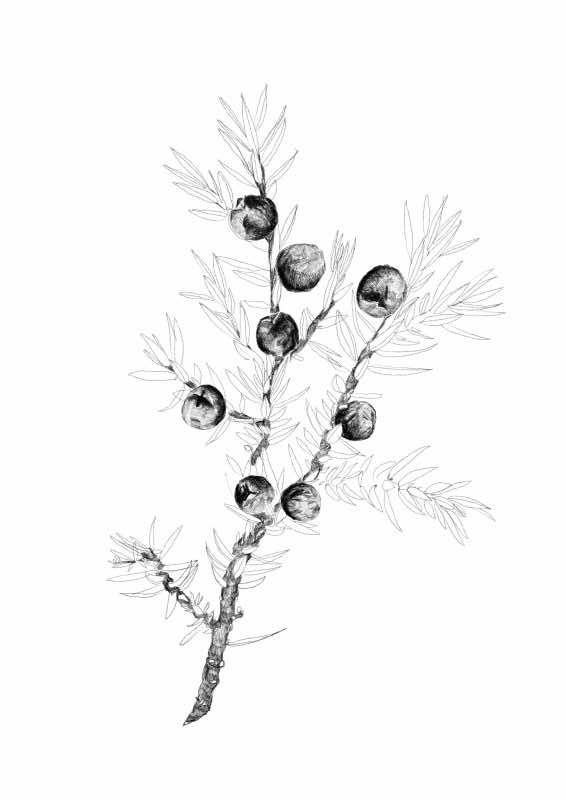
Juniper
The top note of a perfume unfolds as soon as the bottle is opened and the fragrance is released. It is perceived only briefly and generally consists of a light, fresh and stimulating leafy-green scent which leaves behind an initial impression and then gradually fades after around 15 minutes. Juniper, which belongs to the cypress family, is a special and masterfully implemented top note: it has a herby, green, aromatic scent, a balancing, clarifying effect and improves the ability to concentrate.
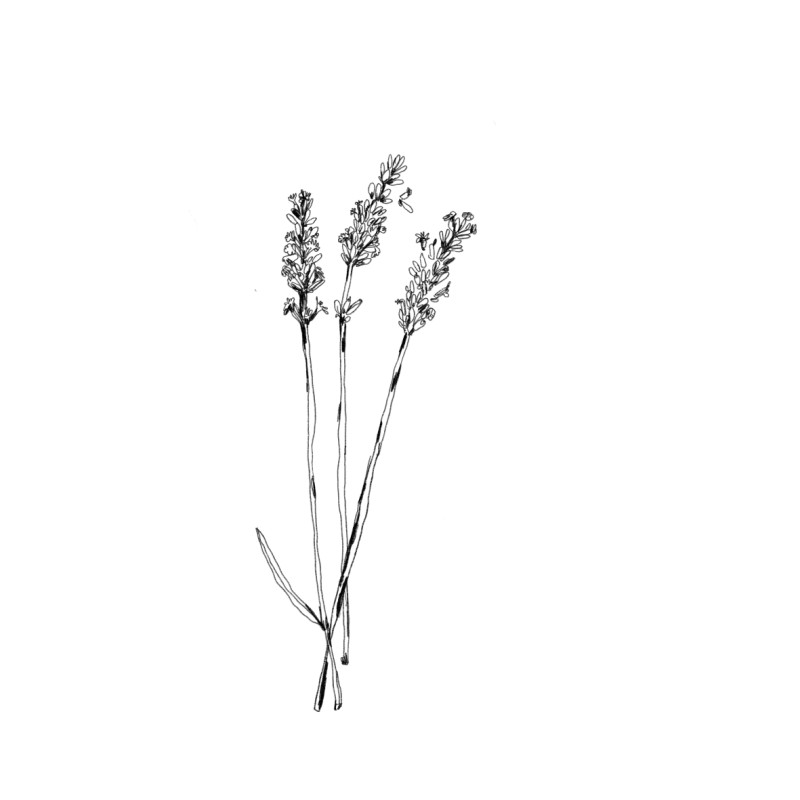
Lavender
Real lavender originally comes from the mountainous coastal areas of the Mediterranean, especially Spain, France and Italy. The small shrub bears spike-like purple flowers on tall stems. The scent of the flowers is strongly aromatic. The plant's essential oil is obtained by steam distillation from the flowers, which are harvested early in the morning. Lavender is used in medicine as a calming agent; when used in bath additives, it nourishes the skin, calms inner restlessness and makes it easier to fall asleep.
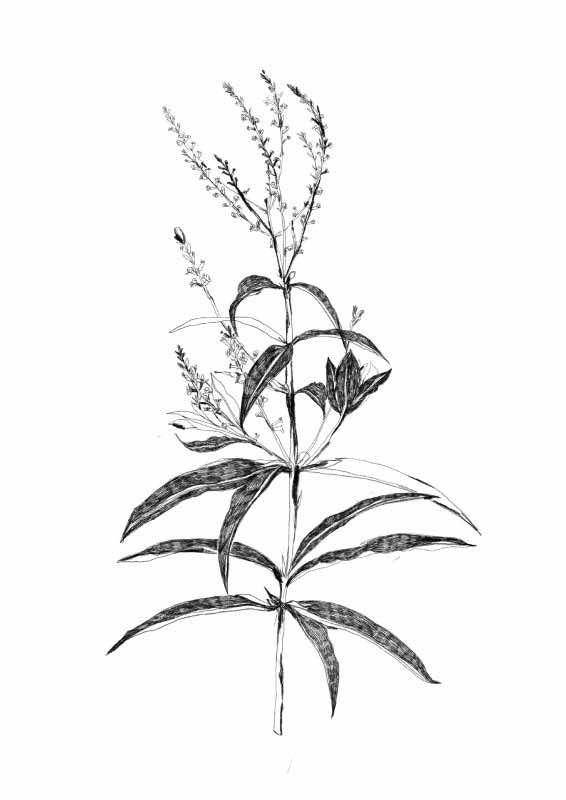
Lemon verbena scent
Lemon verbena, also known as lemon beebrush, originates from the subtropical areas of South America and was first introduced to Europe by Spanish seafarers at the end of the 18th century. Every part of the plant contains essential oils, but most can be found in the numerous delicate oil glands in its lance-shaped leaves. Even just gently rubbing the leaves produces a wonderfully fresh, lemony fragrance. In aromatherapy, the scent of lemon verbena is considered stimulating, invigorating and cheering.
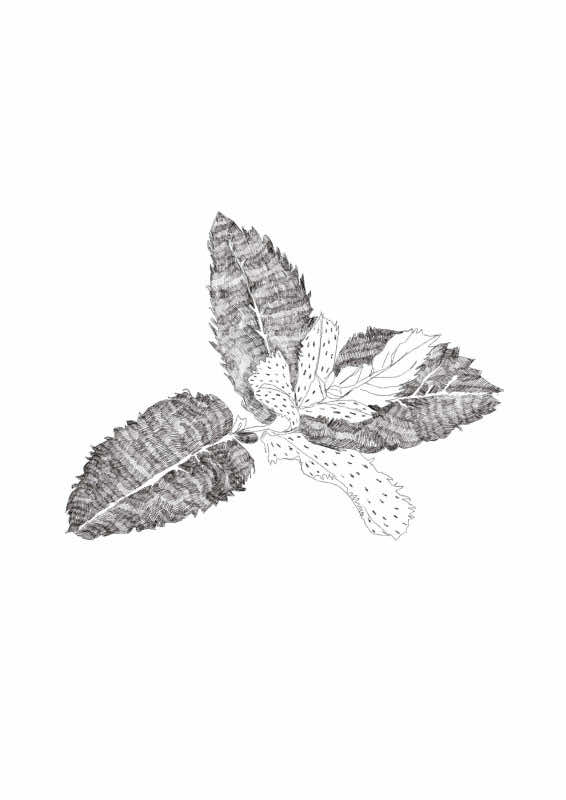
Menthol
Menthol can be found in all essential oils extracted from mint plants and makes up a high proportion of their composition. Principally, menthol is extracted by isolating it from wild mint or peppermint. While menthol is used as a flavouring, it is also cooling and refreshing and is therefore often used as an ingredient in care products: it freshens the skin and the breath. Its additional antibacterial properties are ideal for use preventing tooth decay and gum disease in oral care.
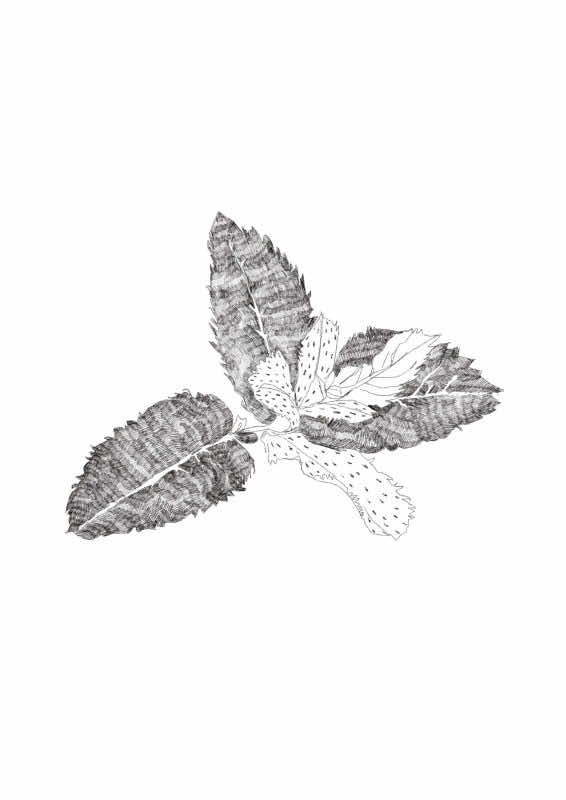
Mint oil
Wild mint grows in nutrient-rich, moist soil in North America and Europe. It differs from other types of mint in that its flowers are arranged evenly and sparsely around the bases of the leaves and up to the top of the stem. Its essential oil contains 90% menthol and is used to obtain menthol; however, it not all of the menthol is extracted. Once it has been partly dementholised, the oil is most often used as a fragrance or flavouring. Thanks to its antibacterial properties, the oil is used to prevent tooth decay and gum disease. The European Pharmacopoeia defines the oil extracted from wild mint as ''mint oil''.
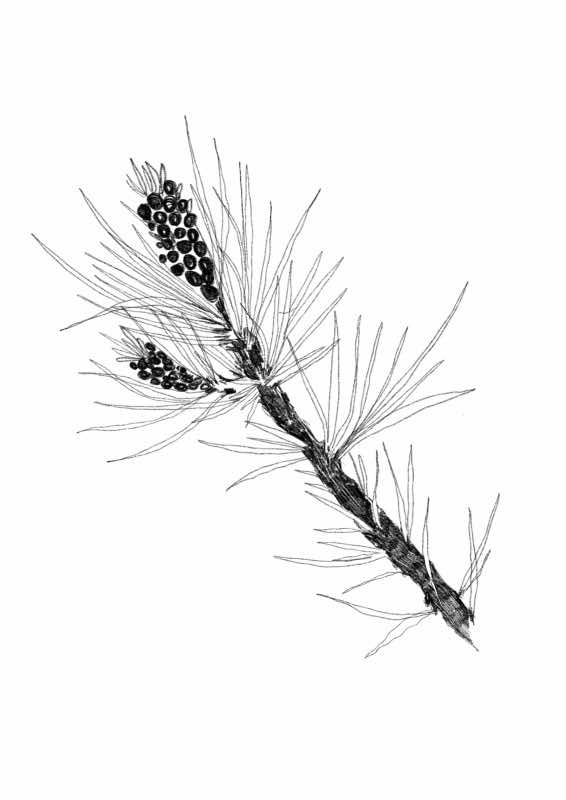
Mountain pine oil
This wild variety of pine grows in the mountains of Europe at an altitude of between 1,000 and 2,700 metres. It is robust and grows widely branched close to the ground, firmly anchored in place, including in places that are prone to avalanches where all the other trees have long since been ripped out of the ground by tumbling snow. It therefore contributes considerably to avalanche protection. The oil of mountain pines farmed commercially and in plantations is extracted from the young branch tips and needles using steam distillation. The essential oil has a pleasant scent and protects the skin against irritation.
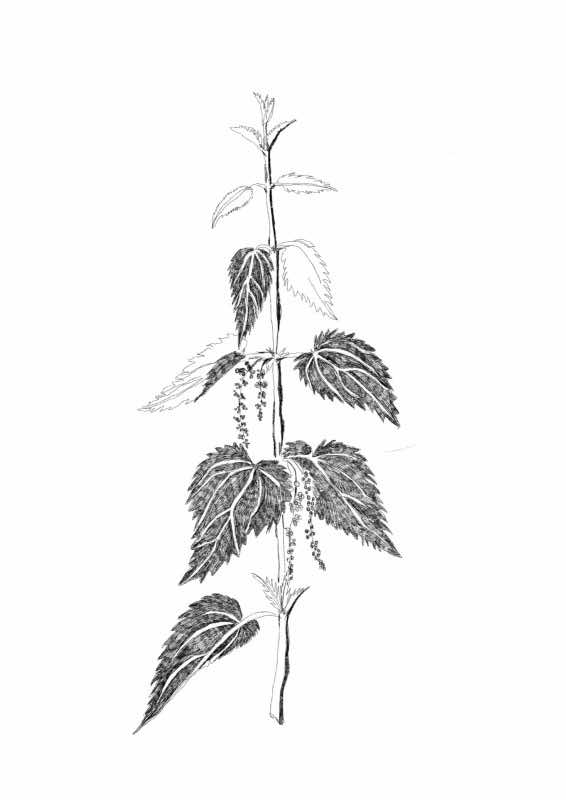
Nettle extract
Nettles can be found all over the world – except in Antarctica. They are undemanding plants that thrive particularly well in nitrogen-rich soil. Stinging nettles can also be used in food and medicines and are cultivated across large areas. Nettle extract taken from the leaves and roots is often used in haircare products because it stimulates blood flow to the scalp. This makes it easier to provide the tissue around the roots of the hair with any nutrients it lacks. The hair looks stronger and healthier.
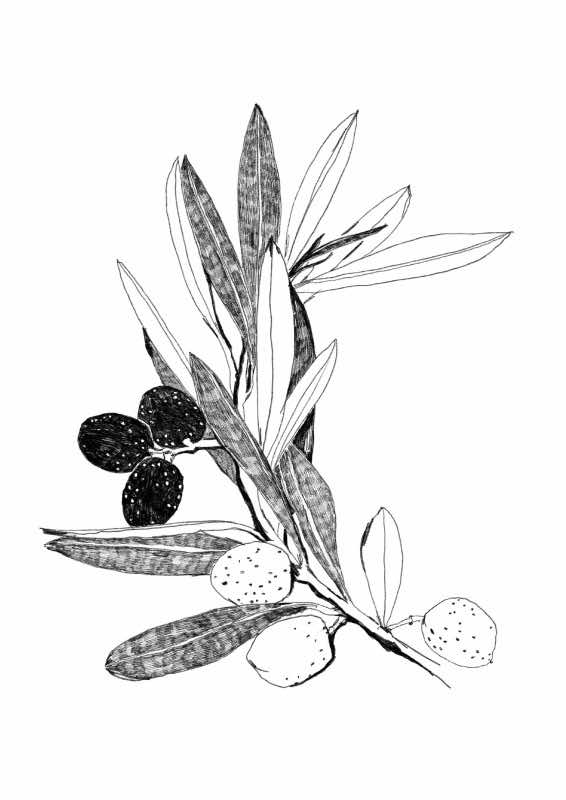
Olive oil
The olive tree can be found everywhere in the Mediterranean region, and the history of its use can be traced back to the bronze age. Its oil has always been valued for use in cooking and care. Olive oil is extracted by cold-pressing the flesh of the olives and is excellently suited for use as a base oil in care products and massage oils. It is absorbed very well – but not too quickly – by the skin and is very skin-friendly. Thanks to its valuable substances such as unsaturated fatty acids and antioxidants, it not only moisturises the skin, but also protects it against harmful environmental influences and irritation.
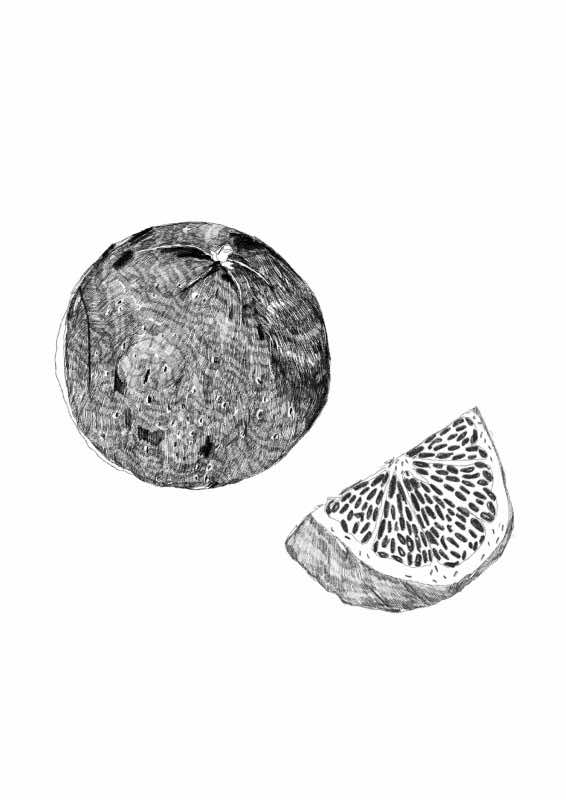
Orange extract
Orange extract is taken from the flesh of ripe fruit and is high in vitamin C. The essence has a pleasantly fresh, fruity and invigorating scent. Care products with this ingredient give the skin a real boost of energy: they stimulate the blood flow and have astringent and antioxidative effects. This way, they revitalise the skin, actively protect it against free radicals, improve its texture and keep it in good condition. The combination of various citrus extracts can even strengthen these effects.
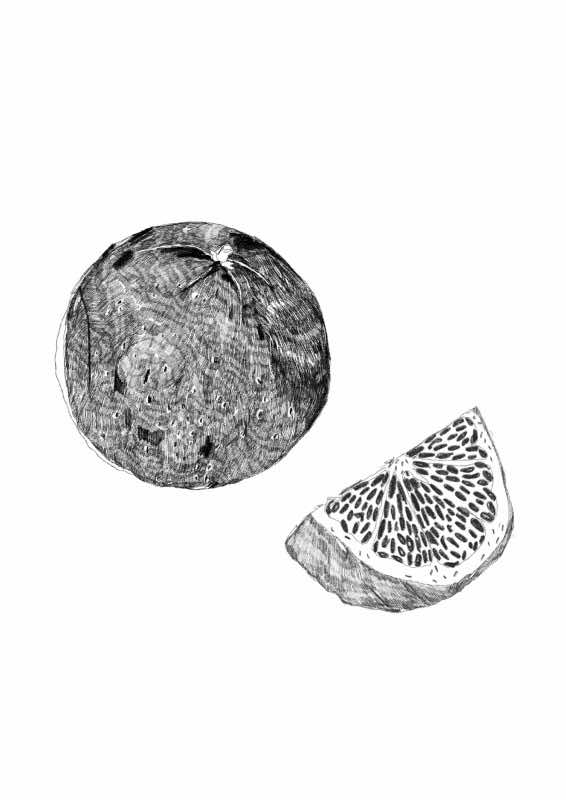
Orange peel
Oranges – a cross between mandarins and grapefruit – grow on small evergreen trees that originated in China or Southeast Asia. They were first documented in Europe in the 15th century. In Europe, they are grown around the Mediterranean. Depending on where they are grown, the ripe fruits are harvested between August and May. The essential oil in the oil glands in the peel has a sweet, fruity scent. When brewed with tea, orange peel adds a tangy, fruity and slightly sweet flavour.
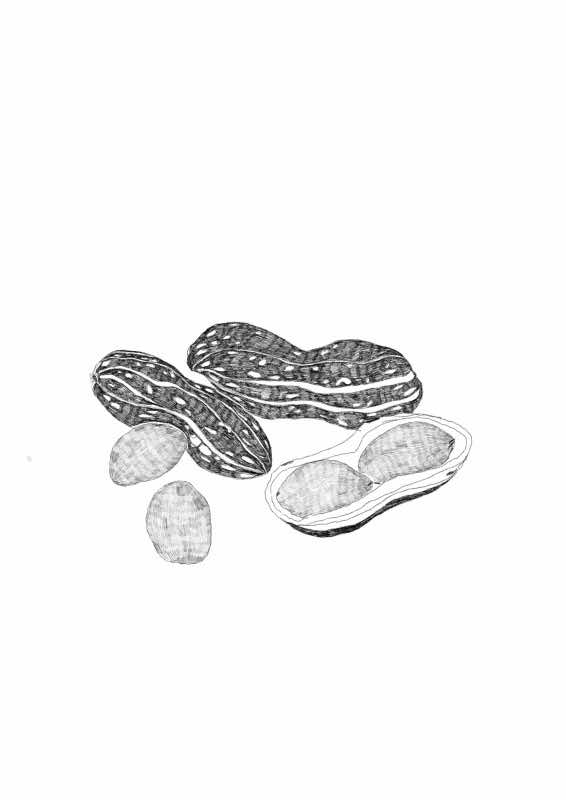
Peanut oil
Originally from the Andes, the peanut plant is now grown across the entire tropical and subtropical region. Its oil is extracted from the peeled nuts which, botanically speaking, are not nuts at all, but legumes. With its moisturising properties and valuable substances such as unsaturated fatty acids, the cold-pressed oil is often used in the care of extremely dry skin, eczema and skin problems such as neurodermatitis and psoriasis. Because the oil is absorbed very slowly by the skin, it is often used as a caring base oil in massage products.
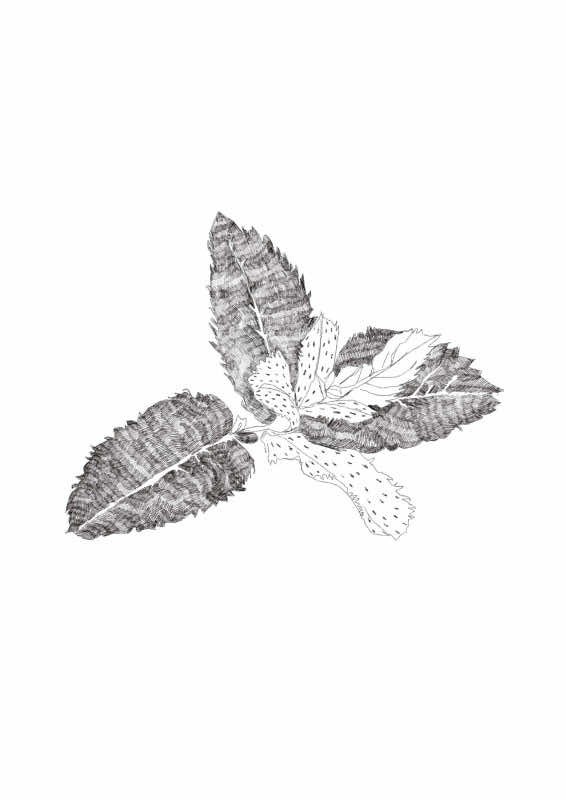
Peppermint oil
Cultivated peppermint is grown in temperate zones in the northern hemisphere. Its pale pink-purple flowers grow in whorls at the tips of the plant. It differs from other mints in its spicy, peppery flavour. The raw oil extracted from the leaves contains around 80 % menthol and is used to obtain natural menthol; however, not all of the menthol is extracted. Once it has been partly dementholised, the oil is most often used as a fragrance or flavouring. Thanks to the antibacterial properties of the remaining menthol, peppermint oil is used in oral care to prevent tooth decay and gum disease.
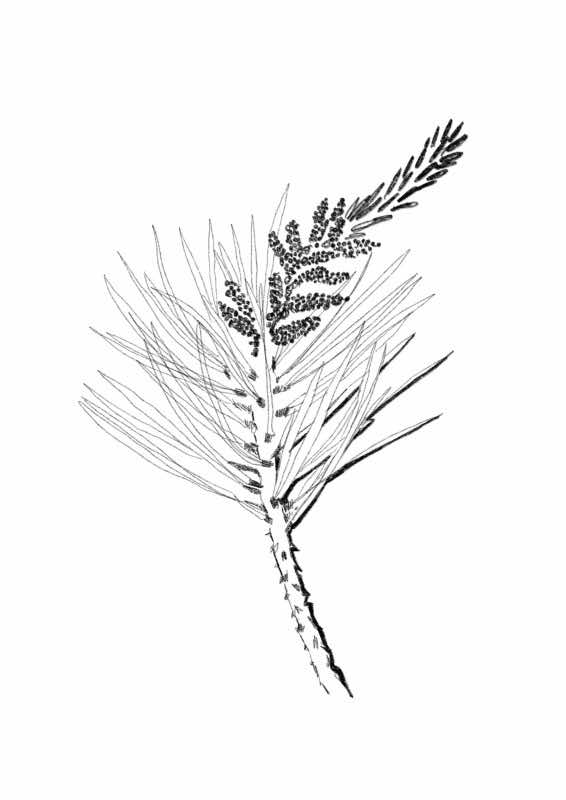
Spruce needle oil
The spruce, which can be identified by its pointed needles, is found in cool and temperate areas all over the northern hemisphere. Its essential oil is extracted from fresh needles and young shoots. The scent of the oil is very intense and reminiscent of a walk through a rain-wet coniferous forest on a summer’s day. Thanks to its positive properties, the oil is often used as an ingredient in bath soaks. A warm bath supports regeneration and relaxes the muscles, while the aromatic vapour has a positive effect on the breathing. The oil is also used to add a distinctive scent to moisturising creams.
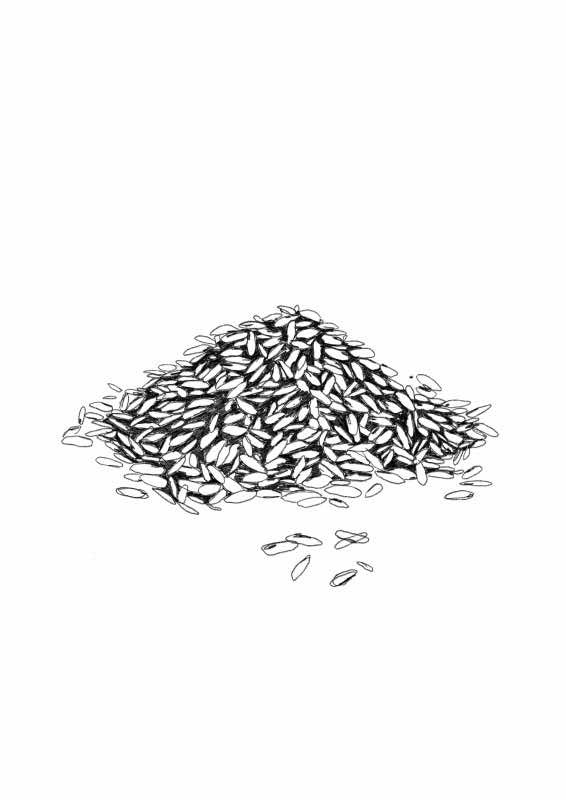
Rice protein
Rice is one of the world’s oldest cultivated plants. The earliest evidence in China points to rice being cultivated as far back as in the 9th century BC. Rice grains consist mainly of carbohydrates, but the outer layer – the rice bran – also contains vitamins, minerals and valuable proteins. Hydrolysis is used to break these down into peptides that trigger anti-ageing effects: they increase the level of moisture in the skin without making it greasy, increase vitality and reduce irritation. The skin is protected against harmful environmental influences and feels generally pleasant and fresh.
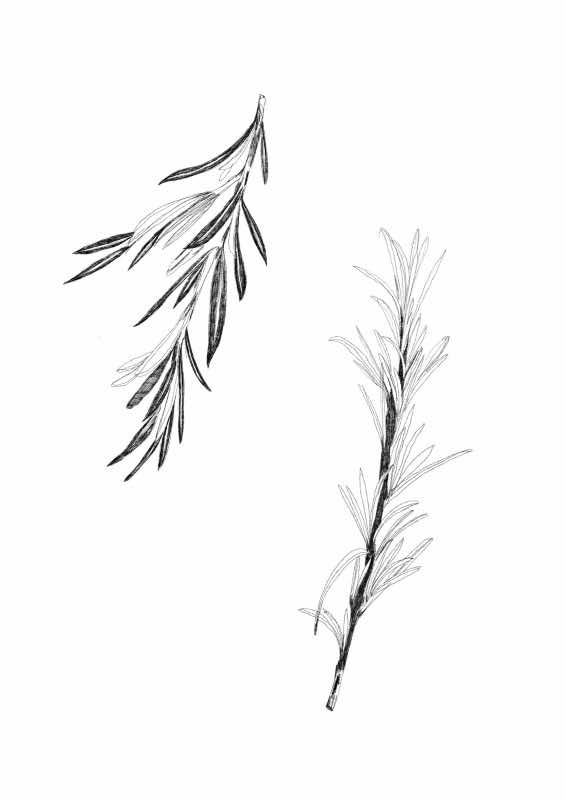
Rosemary oil
Rosemary grows in the European and Eastern Mediterranean and was known for its fragrance and effect as a healing plant back in ancient Greece and Rome. The bushy shrub and its narrow, slightly rolled-in leaves is reminiscent of an intensively herby-scented conifer. The oil is obtained by steam distillation of the herb. In care products, the oil supports blood flow, provides the skin optimally with oxygen and stimulates cell metabolism. All of this has a positive effect on the skin and the connective tissue.
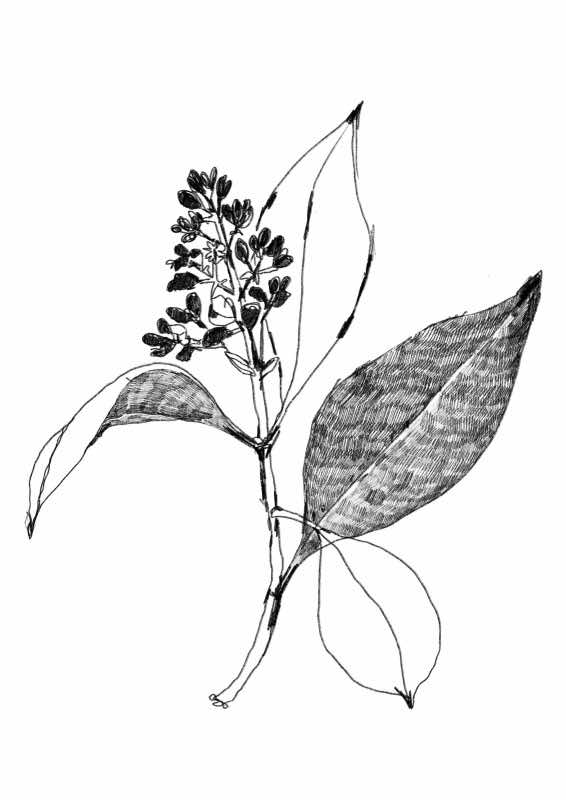
Sandalwood
The base note of a perfume forms the last phase of the fragrance and is what lingers the longest. Resinous, woody aromas that are heavy and therefore evaporate very slowly are preferable. Sandalwood trees are mainly cultivated in India. To make the oil, the roots, branches and heartwood are chopped and distilled. The scent of the oil is described as woody, sweet and earthy. It is known for its balancing effect. It calms, relieves anxiety and tension and takes you back to a feeling of inner calm and harmony.
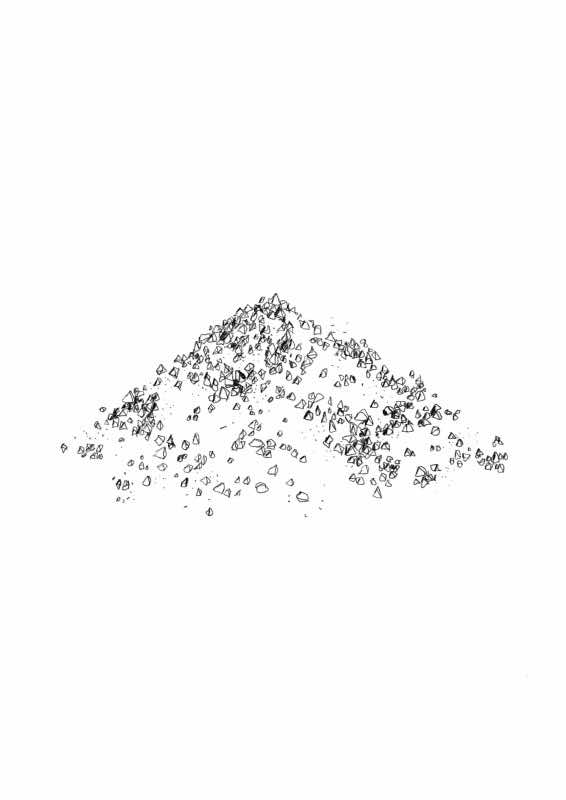
Sea salt
Sea salt differs from conventional table salt in that it contains significantly more valuable minerals. In addition to sodium chloride, sea salt includes a variety of minerals and trace elements that can all be easily absorbed by the skin thanks to the composition of salt water: perfect for all liquid cleansing products intended to care as well as cleanse. Sea salt dissolved in oral care products helps to reduce bacteria in the mouth, prevents inflammation and keeps the gums, mouth and throat in good condition.
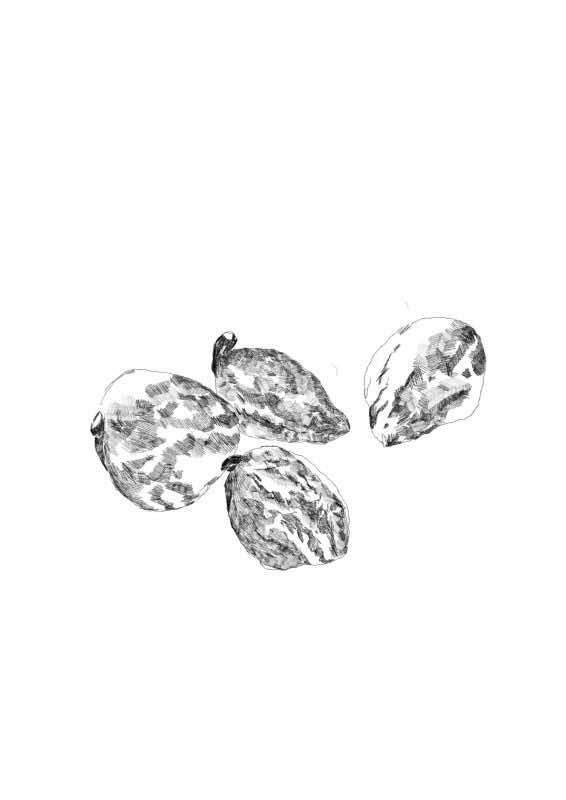
Shea butter
The shea tree is indigenous to the savannah region between Senegal and Sudan. Nuts from the fruit are used to make shea butter in a multi-step process. The butter keeps for a long time without the need of cold storage and will not become rancid. When applied to the skin, it melts, is absorbed quickly and moisturises without blocking the pores. The high proportion of valuable substances such as allantoin, vitamin E and fatty acids such as Omega-3 care for the skin and have a positive effect on its regeneration. They soothe and prevent inflammation. When used in hair care, shea butter makes dull hair easy to comb and reduces split ends.
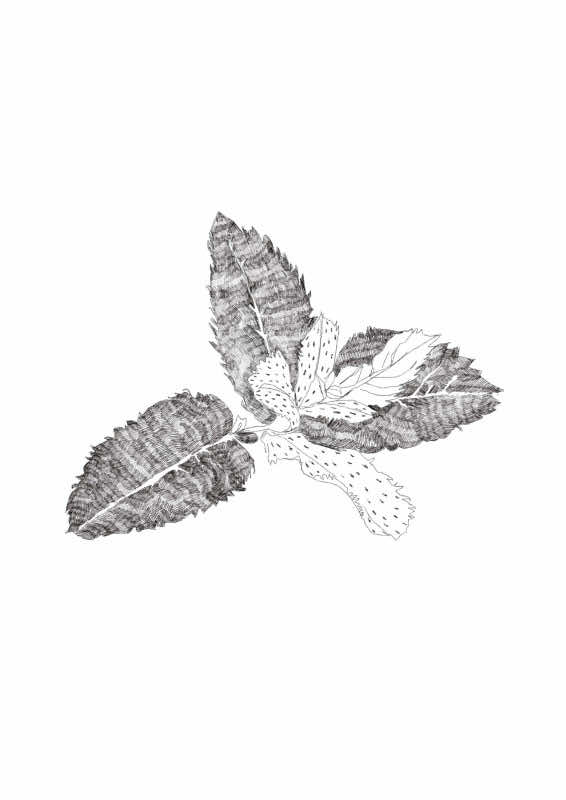
Spearmint
Spearmint is a crop widely planted across the temperate zones of the northern hemisphere. Its fine aroma comes from the essential oil that can be found predominantly in the leaves. This oil contains only a small amount of menthol. This means that the flavour released when the dry leaves are placed in hot water is less sharp, and is instead pleasantly fresh, mild and almost sweet. Spearmint is an elegant and refreshing component in delightful tea creations.
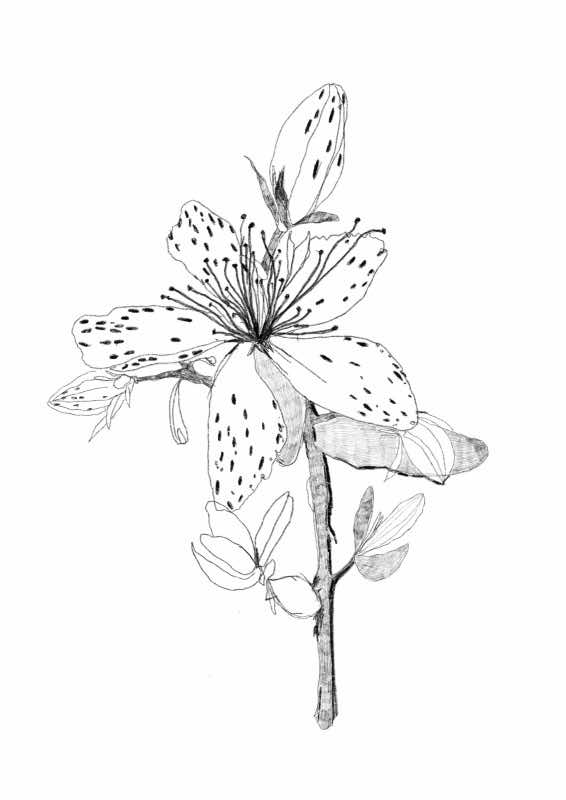
St. John's wort extract
True St. John's wort is common in Europe, East Asia and North Africa. Its erect stem ends in an umbel-like, multi-branched blossom with five yellow petals to each flower. However, it is commercially cultivated for use as a medicinal herb or ingredient in care products. The buds, flowers and ends of the twigs are harvested, dried and processed. Rich in substances such as tannins, flavonoids and hyperforin, St. John's wort is used to care for and moisturise stressed, dry and coarse skin and alleviate itching.
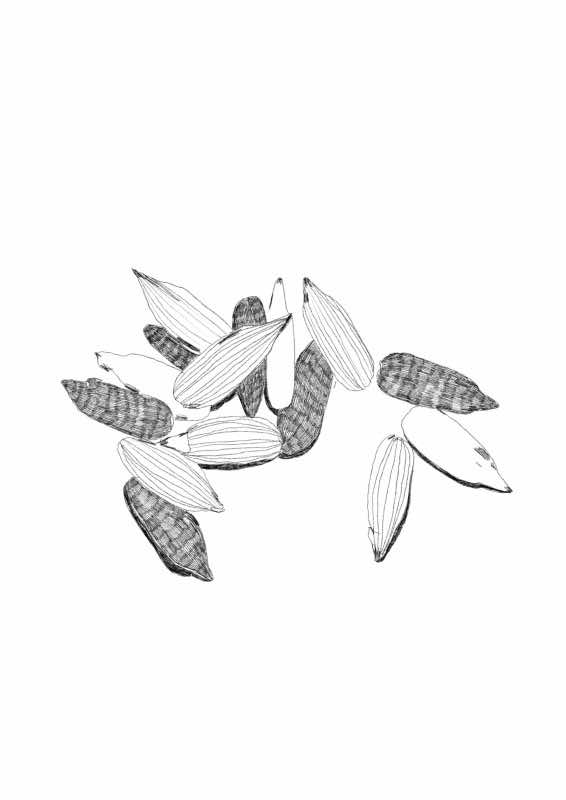
Sunflower oil
Spanish seafarers brought sunflower seeds from Central America to Europe in the mid-16th century. This mighty plant, which can grow to 1–2 metres or taller, has a large flower with characteristic yellow ray flowers and an inner circle of brown disc flowers. These mature into fruits that produce seeds from which the clear, light yellow oil is extracted. It is the perfect base oil for care products because it is very skin-friendly and absorbs quickly without leaving a greasy residue behind. The oil has caring properties: its high vitamin C content alone protects the skin against harmful influences.
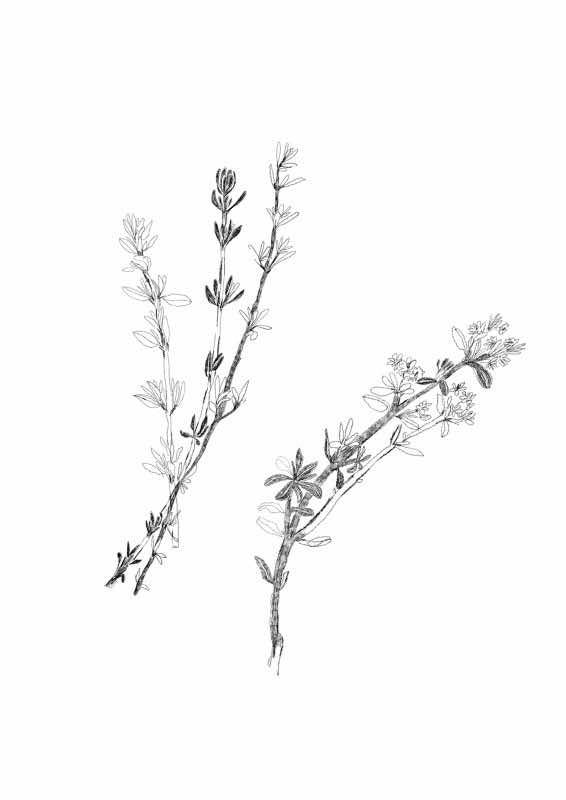
Thyme oil
True thyme belongs to the Lamiaceae family and is common across the Mediterranean region. The essential oil extracted from the shrub is obtained through the steam distillation of the parts of the flowering plant that grow above ground. The main component of thyme oil is thymol, which is used in care products to protect the skin against impurities and inflammation. Adding a few drops of thyme oil to a bath prevents coughs and colds and alleviates muscle and joint complaints. The scent helps to shake off stress and re-establish a spiritual balance.
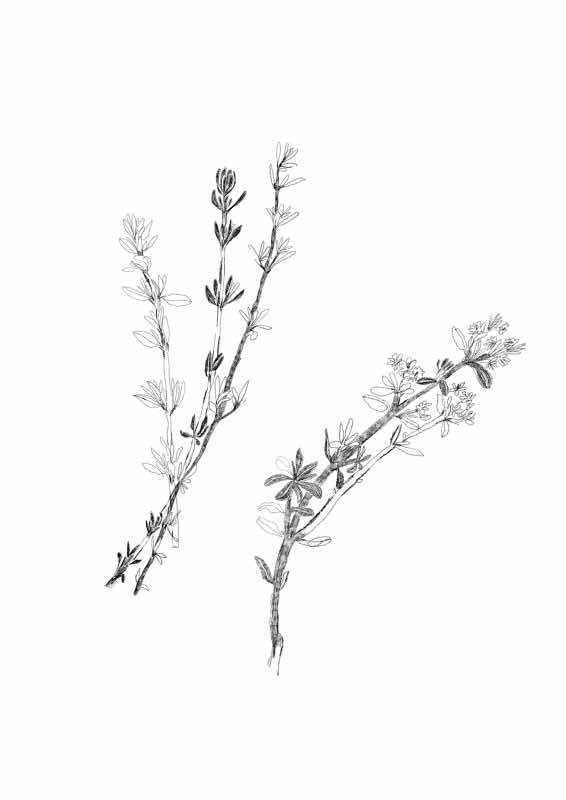
Thymol
Thymol is a main component of thyme oil, but is also found in other essential oils from plants of Mediterranean origin. The colourless crystals were first isolated from the oil in 1719. In scientific literature, thymol is described as having antioxidative, antibacterial, disinfectant and anti-inflammatory properties. When used as an ingredient in care products, thymol protects the skin against harmful environmental influences, supports its rapid regeneration and keeps it in good, healthy condition.
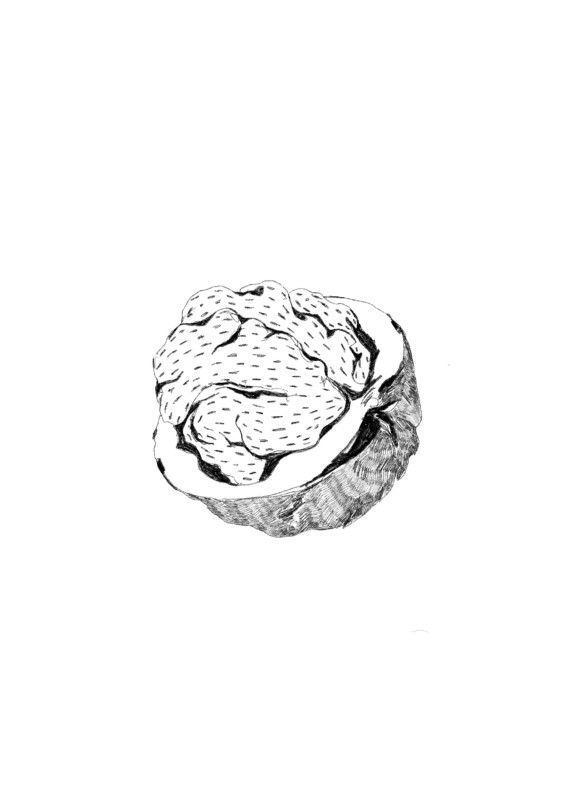
Walnut shell extract
Introduced from the East, the walnut tree was planted all over Southern, Central and Western Europe in Roman times. Many parts of the tree, such as its bark, leaves and in particular the hulls of the fruit have always been used to dye materials, hair and skin. Walnut extract comes from the walnut fruit hull and is one of the world’s oldest tanning products. This lightly tanning substance is gentle and adheres well to the skin. However, it doesn’t sink into the skin – it can easily be washed off with water or a caring soap.
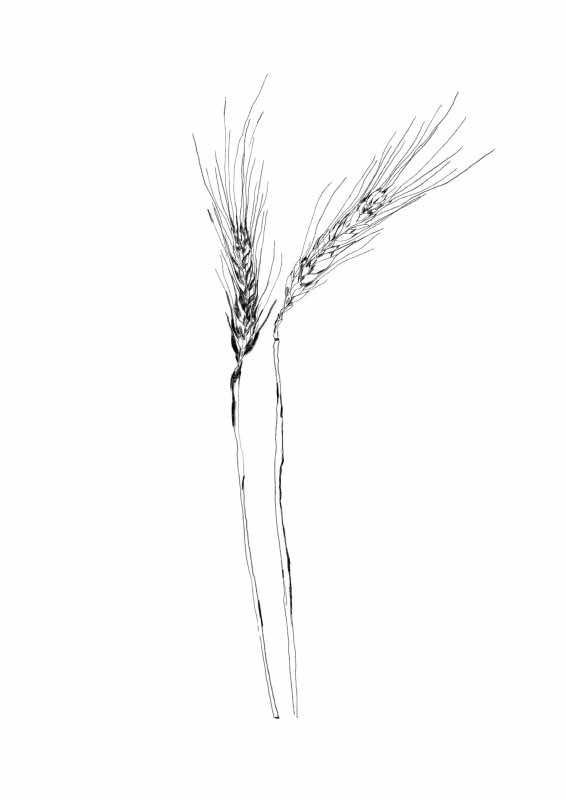
Wheat protein
The first recorded species of wheat to be planted, Emmer and Einkorn, originate from the fertile crescent on the Tigris and Euphrates rivers that was home to early civilizations. The wheat planted today still needs a warm, dry summer to grow successfully and is therefore more demanding than other crops. The wheat protein used in skincare is taken from the wheat germ and is rich in protein, amino acids and vitamin E. Sensitive, mature or damaged skin is protected, strengthened and optimally cared for; moisture and vitality are restored to dry skin; and the skin’s surface appears smoother.
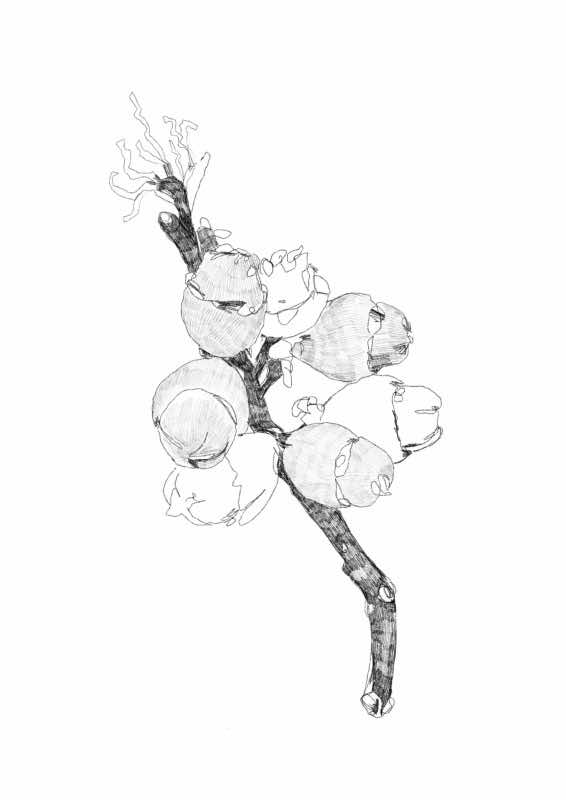
Witch hazel extract
Native to North America, witch hazel (Hamamelis Virginiana) now grows throughout the northern hemisphere. Unlike other members of the witch hazel family, it doesn’t bloom in winter; instead, its bright yellow tuft-like flowers bloom in autumn. The extract taken from the leaves contains tannins, flavonoids and essential oils. As an ingredient, it is particularly well suited for caring facial toner because it refreshes, clears the skin and has antioxidative effects. The skin feels firmer, while itching and irritation are reduced.
THE POWER OF NATURE
Our plant-derived main ingredients
The most important ingredient in the Retterspitz product range is thymol, a constituent of thyme essential oil which was first isolated by chemist Caspar Neumann in 1719. In scientific literature, thymol is described as having anti-microbial, anti-inflammatory and anti-oxidative properties.
Other typical Retterspitz ingredients include chamomile extract, peppermint, rosemary, eucalyptus and olive oil.
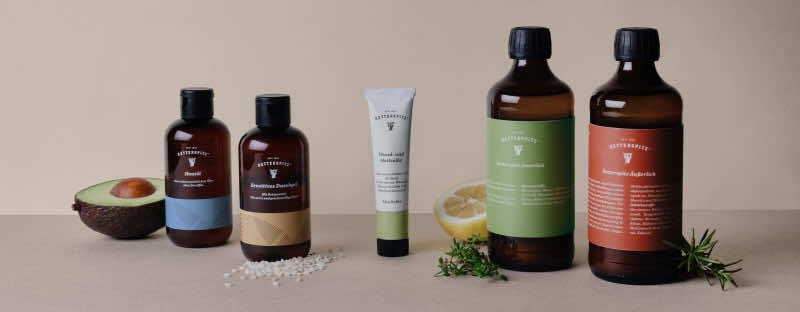
Application of Retterspitz products
Discover additional tips